"Bent Skovmand is not exactly a household name,
but he has more to do with the welfare of the
earth’s 5 billion people than many heads of state."
− Eugene Linden,
Time Magazine, August 19, 1991
Dr. Bent Skovmand died on February 6, 2007 at age 61. At the time he was Director of the Nordic Seed Bank, and oversaw the development of the Svalbard International Seed Vault (the so-called "Doomsday Vault" for crop plant diversity). This unique seed vault is located on the Norwegian Island of Spitsbergen near the Arctic Circle.
Bent Skovmand understood that genetic diversity of crop plants, like the air we breathe and the water we drink, is fundamental to human survival on earth. He also knew that no nation is self-sufficient in crop plant diversity. He observed that crop plant diversity was undergoing mass extinction. The forces of human population growth, political instability, ill-informed land use policies, plant breeding practices, and climate change served only to accelerate that extinction.
How did Bent Skovmand become a renowned champion for practical genetic conservation of crop plants and their wild relatives? Who was he? Where did he come from? What scientific/philosophical route did he follow? Why was what he accomplished and what he stood for considered important? Why was he notable enough that the author, playwright, and social historian Susan Dworkin immortalized him in the 2009 biography entitled
The Viking In The Wheat Field?
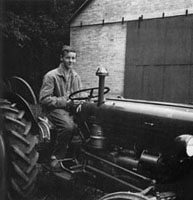
Fig. 1. Young Skovmand driving tractor on a Danish farm. (Skovmand Family collection photo, courtesy of Susan Dworkin’s
The Viking in the Wheat Field, with permission of the author and Walker & Company, 2009). | |
"Life can only be understood backwards;
but it must be lived forwards."
− Soren Kierkegaard, Danish philosopher,
theologian, and psychologist
Bent Skovmand was born on January 25, 1945 in Denmark. As a child and teenager he worked on local farms (Fig. 1). He was bright, imaginative, energetic, and fun-loving. He read extensively and greatly enjoyed playing chess with his father, the Reverend Sigurd Skovmand. Young Bent grew up in the European aftermath of World War II. He idolized Dag Hammarskjöld, the Swedish Secretary-General of the United Nations, who perished in a 1961 airplane crash when Bent was 16 years old. Bent Skovmand also wanted to contribute to the betterment of humanity. He thought globally and prayed for world peace. He dreamed of horizons beyond his native Denmark. Early on he said to a high school classmate,
"I think Denmark is just too small for me."
After high school he joined the Danish army, serving as a second Lieutenant and tank commander. A good horseman, he was also accepted into and served with Denmark’s elite equestrian unit, the Bornholm Brigade (Fig. 2). His military experience reinforced in him the importance of discipline, planning, and leadership.
Then in 1966 Dame Fortune, the goddess of fate, smiled upon this young soldier. He applied for and was accepted into the Minnesota Agricultural Student Trainee Program (MAST). He was to leave Denmark for the United States of America and expand his personal horizons. Minnesota’s MAST program enabled him to spend a year (1967-1968) on a farm in southwestern Minnesota. There he worked hard and grew very fond of the owners, Grant and Ester Lee. The Lee family became his life long friends (Fig. 3).
| |
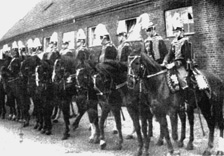 | |
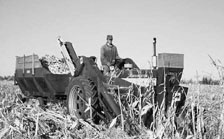 |
| |
Fig. 2. Third from the right is Lieutenant Bent Skovmand of the elite Bornholm Equestrian Brigade. (Skovmand Family collection photo, courtesy of Susan Dworkin). | |
Fig. 3. Bent Skovmand in 1967 harvesting maize on the Lee family farm in southwestern Minnesota. He spent a year there as part of the University of Minnesota’s Minnesota Agricultural Student Trainee Program (MAST). (Photo from the Skovmand family collection). |
The MAST program also enabled him to sit in on classes at the University of Minnesota’s Saint Paul Campus. The University’s faculty and their involvement in international agriculture inspired him. He jumped at the chance to pursue higher education in this environment. Thus, in 1969 he enrolled in a Plant Biology major within the College of Agriculture, administered by Department of Plant Pathology faculty. He got an undergraduate laboratory assistant position. It paid him by the hour and he put in many hours. He worked hard, was reliable ,and lived frugally. His first brush with research came under the direction of Drs. Ernest Banttari and Richard Zeyen, and involved leafhopper vectoring of the Oat Blue Dwarf Virus. Later, he switched to a barley and wheat disease program involving stem rust resistance under the direction of Professor Roy Wilcoxson. Bent Skovmand received a baccalaureate degree in 1971.
His obvious talent, drive, work ethic, and maturity were duly noted. Professor Wilcoxson offered him a graduate assistantship to do research on slow rusting in wheat. Bent remained fun-loving and was popular with fellow students. Nevertheless he was a serious student and an earnest learner. He also proved to be an insightful, patient, and conscientious researcher. He earned his M.S. in Plant Pathology in 1973.
Bent Skovmand, like all Minnesota graduate students of that era, had access to the elder statesman of Minnesota plant pathologists, Emeritus Professor Elvin C. Stakman. Stakman, although retired from the University, remained a member of the Plant Pathology Department’s Graduate Faculty. He was also an active Rockefeller Foundation agricultural consultant. Stakman was a genius when it came to recognizing talent. He helped place many plant pathology graduates where he knew they could succeed. Although he was nearly 90 years old, Elvin Stakman befriended and mentored this energetic, idealistic, and dedicated graduate student.
Bent Skovmand told Stakman and his graduate advisor Roy Wilcoxson that he would like to enter international agriculture. Stakman smiled, already having identified just the place where this young man could fit and succeed. Elvin Stakman arranged for Bent to meet a former student and Minnesota Plant Pathology alum, the 1970 Nobel Peace Prize recipient, Dr. Norman Borlaug. Bent’s knowledge, energy, and sincerity impressed Norman Borlaug. In turn, Borlaug recommended Skovmand to the Director of CIMMYT (International Maize and Wheat Improvement Center) in Mexico. When he received his Ph.D. (1976) in Plant Pathology from Minnesota he was immediately hired by CIMMYT (Fig. 4).
| |
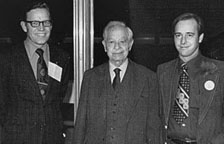
Fig. 4. Left to right, Professor Roy Wilcoxson (Bent’s major advisor) Emeritus Professor Elvin Stakman, and Bent Skovmand. Photo from the Skovmand family collection. The photo was taken the evening of Bent’s successful 1976 Ph.D. thesis defense. | |
Bent Skovmand moved his young family to Mexico and became a postdoctoral fellow in the bread wheat program at CIMMYT. There he learned practical wheat breeding protocols from new mentors like Drs. Norman Borlaug and Sanjaya Rajaram, among others. His days were filled with making wheat crosses. His nights were filled with talking and thinking about wheat. He lived wheat. In Stakman’s terminology Bent Skovmand became a "wheat apostle." It was a great experience and Bent loved it! As part of CIMMYT he clearly saw the horizon he had been searching for. He understood that through his work he was contributing to the greater good of humanity!
| |
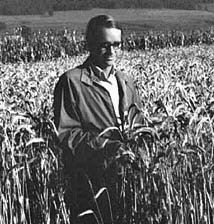
Fig. 5. Dr. Bent Skovmand examines a test planting from his CIMMYT triticale breeding program, circa 1980. He headed the triticale program for 5 years. (Photo from the Skovmand Family collection). | |
In 1978 Bent Skovmand was assigned to CIMMYT’s triticale program under the direction of Dr. Frank Zillinsky, the organization’s "Father of Triticales." Zillinsky had greatly improved this rye-wheat artificial hybrid cereal plant. His variety
Armadillo had excellent fertility and stress tolerance. Then, a serious illness overtook Frank Zillinsky, forcing him to retire. So, in 1979 Bent Skovmand was named CIMMYT’s triticale breeder (Fig. 5). Bent and his collaborators worked hard to improve the rye parents of triticale. Soon they produced early maturing, smooth seeded, high yielding triticale varieties for farmers plagued with poor soil types.
The improved triticale varieties actually out-yielded CIMMYT bread wheats by 30% on some soil types. However, they did not yet match wheat for bread baking quality, nor were they up to standard for Mexico’s taste buds. Although beer brewed using these triticale plants tasted fine, it was cloudy. Triticale-based beer was rejected by brewers. Undaunted, Skovmand believed that triticale was on the verge of overcoming taste and baking shortcomings. He and other triticale supporters tried to establish a North American grading and marketing system for triticale grain. Ultimately, they were unsuccessful. Then, with little warning CIMMYT’s triticale program was halted. Closing down the program was a high level administrative decision coinciding with a severe financial crisis that overtook the organization in the early 1980’s. In addition, Bent Skovmand’s marriage disintegrated, leaving him alone in Mexico.
Bent Skovmand toiled through his frustrations and personal sadness. On the bright side, his CIMMYT triticale varieties spread throughout the world. They were popular in Eastern Europe where farmers, working poor soils, welcomed these high yielding varieties. They grew them as livestock feed, and where rye bread was popular, these triticale varieties were sometimes used for breads. Thus, Bent Skovmand’s reputation as a plant breeder was enhanced, despite the demise of CIMMYT’s Triticale Program.
In 1984 Dame Fortune once again smiled, and sent him on a journey that would lead to fulfillment. Bent Skovmand remarried. Then he joined an ongoing program in Turkey designed to improve winter wheat. He was "on loan" from CIMMYT to this United Nations effort. The program objective was to make Turkey a world center for producing and improving winter wheat, much like Mexico was for spring wheat.
Bent’s sociability, experience, and hands-on approach helped him and his colleagues to accomplish what was needed in Turkey. His take-charge nature and strategic thinking facilitated progress with farmers, scientists, and government officials. He brought palpable energy and advanced logistical planning to the program. Overall, he and his colleagues helped wheat farmers prosper in the varied geographic growing regions of Turkey.
The genetic improvement portion of the project in Turkey also involved collecting winter wheat landraces (wheat varieties adapted to very specific locals) and older varieties for genetic material to help achieve specific breeding objectives. To this end, Bent literally canvassed the world for diverse winter wheat varieties. He was very successful. One example was when a colleague, Dr. Hans Braun, collected landraces of wheat from the Afghanistan-Pakistan border for improvement. The intent was to return improved wheat seed to Afghan farmers. The landraces were crossed with Turkish varieties and were greatly improved. Then Braun and Skovmand tried to return these improved wheats to their original regions to help local farmers prosper. However war reached Kabul, Afghanistan simultaneously with Drs. Skovmand and Braun and their improved wheats. The war forced them to abort their mission. Despite this setback, collecting and evaluating wheat landraces and old varieties for improvement had piqued Bent’s interest. Fellow scientists and CIMMYT administrators took note of his interest in "genetic" preservation.
In 1988 Bent was asked to head the Wheat Genetic Resources program at CIMMYT in Mexico. It was a
carpe diem opportunity for Bent. He loved CIMMYT and his new wife Eugenia, a native of Mexico, yearned to return home. Brimming with ideas and enthusiasm he took up the challenge. Having previously done plant breeding he viewed genetic preservation through the lens of that experience. Just preserving seeds and being the curator of a "seed museum" made no sense to him. To Bent Skovmand genetic preservation and seed collections should fulfill current and future practical needs.
Bent wanted the core of the wheat genetic resource collection to be
used. To be useful the collection needed to be annotated with high quality information of practical and immediate value to wheat breeding. He threw himself fully into this wheat genetic preservation effort. He traveled the world visiting seed banks collecting and exchanging wheat and wheat relatives. Together he and his staff identified and recorded those specific plant traits that were useful to both breeders and preservationists. They computerized this information into a useable public database called IWIS, (the International Wheat Information System). IWIS was made freely available on two easily copied CD’s. They were given to all who wanted the information, and users were encouraged to make copies and pass them on to others. IWIS became a precursor to even more extensive and sophisticated collection annotation systems in use today.
From his plant breeding experiences he understood why breeders working with rather narrow "elite" germplasm bases abhorred making crosses to wild relatives of wheat or even to wheat landraces. There was simply too much "genetic drag." Too many undesirable traits came along with desired trait(s). The only remedy is a long, laborious series of backcrosses and screening to eliminate undesirable traits. This remedy is time-consuming and something elite germplasm breeders avoid at all costs. Thus, Bent Skovmand and his collaborators helped breeders. They did "prebreeding" to put important genetic traits into wheat backgrounds to make the needed traits more breeder-friendly.
At the same time, he and CIMMYT’s maize program director, Dr. Taba, solicited and got funding from the governments of Japan and Denmark to build world-class storage facilities in Mexico. Soon wheat breeders and those in charge of seed banks throughout the world came to rely heavily on Bent Skovmand. He was a "scientist’s scientist" and more. Bent was an honest, reliable, and highly valued partner and collaborator. He was the world’s "go to" person for those seeking any strain of wheat with a particular characteristic (Fig. 6).
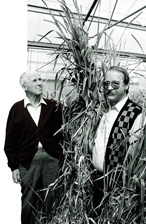
|
| Fig. 6. Norman Borlaug (left) and Bent Skovmand with a group of genetically diverse wheat strains, circa 2002. Many years previously, Borlaug had collected Spanish landraces of wheat throughout Central and South America; however, the collection was lost due to poor storage facilities. Skovmand and his colleague Julio Huerta spent a decade replacing and documenting a new Spanish landrace collection. (Photo from Skovmand family collection). |
|
After an initial period of skepticism, Bent Skovmand accepted biotechnology and what it could offer. However, he was philosophically and diametrically opposed to patenting and privatizing of genetic resources. He often expressed his view with the following:
"Patenting individual genes is like copyrighting each and every word in Hamlet
and saying no one can use any word used in Hamlet
without paying the author." He was also somewhat unpopular for his unshakable defense of free and open exchange of genetic materials. For example, he opposed the 2001 FAO International Treaty on Plant Genetic Resources. He believed the treaty would create unnecessary bureaucracy and politicize genetic exchanges and prevent effective preservation. But he couldn’t do anything about these forces. Thus, while receiving many international awards and accolades for his superb work he was, at the same time, on a collision course with those in CIMMYT and elsewhere who advocated patenting and privatization of genetic resources.
The year 2003 was rewarding but also deeply challenging and stressful for Bent Skovmand and his family. He received the Frank N. Meyer Medal for Plant Genetic Resources from the Crop Society of America. Queen Margrethe II of Denmark honored him with the Knight’s Cross of the Order of Dannebrog, knighting him for his service to humanity (Fig. 7). Then in April of 2003 CIMMYT made "Sir" Bent Skovmand and many other senior staff members redundant. It was not entirely unanticipated because CIMMYT was near collapse. Nevertheless it was harsh shock. The old CIMMYT organization Bent Skovmand had known and loved seemed in collapse and was antithetical to his philosophy and deeply held beliefs.
| |
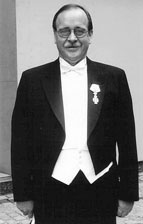
| |
| |
| Fig. 7. Sir Bent Skovmand at the royal palace in Denmark where he presented his credentials to Queen Margrethe II.(Photo from Skovmand family collection). |
| | | |
However, Dame Fortune again smiled on Bent Skovmand. He interviewed for and was appointed Director of the Nordic Gene Bank (NGB) in Alnarp, Sweden. The NGB is an international center for conservation, documentation, and utilization of plant genetic resources. Funded by a consortium of Nordic countries, their philosophy matched his. He had found his scientific and philosophic "home." Although his health was questionable he poured his energy into this new position. His considerable skills, personal contacts, ability to converse in several languages, and lifetime of experience were being used to best advantage. It was satisfying and he loved the NGB and the people working there. Once again, Bent Skovmand was contributing to mankind in a very meaningful and philosophically compatible way.
As NGB Director, Bent was heavily involved in the expansion planning and construction of the Svalvard International Seed Vault. The seed vault was inside a deserted Norwegian coal mine. It had natural climate control features needed for seed storage. It is deep inside a mountain on Spitsbergen Island near the Arctic Circle. It is 130 meters above sea level and secure from rising oceans caused by climate change. This seed vault fired the world’s imagination. It became popularly known as "The Doomsday Vault" or the "Noah’s Ark" or the "Fort Knox" of seed banks (Fig. 8). To many it represents the world’s storehouse and best hope for preserving crop genetic diversity. According to Bent Skovmand’s calculations and plans it would hold from 3 to 5 million accessions.
The Svalbard Vault was designed to preserve seed stocks for most of humankind’s major food crops for hundreds of years to come. Also, Bent and his colleagues wanted the seed vault to be safe from civil strife, nuclear war, and natural catastrophes. They wanted it to be financially secure and have competent long-term management. This led to the later establishment of the Global Crop Diversity Trust. This trust ensures funding and good management for the seed vault.
| | Fig. 8. Artist’s sketch of the Svalbard Global Seed Vault. It is located on the Island of Spitsbergen near the Arctic Circle. Built in an old coal mine, it requires no artificial cooling. It is secure from environmental catastrophes and holds seeds of crop plants from all nations of the world. (Photo from the Global Crop Diversity Trust). |
|
Bent Skovmand’s
modus operandi was to speak truthfully and to be hands on whenever possible. Working on the Svalbard Seed Vault was no different. He helped acquire financial support, and was heavily involved in the day-to-day planning. He began advising and negotiating with other seed vaults across the globe. Despite failing health he traveled to the Baltics, the Caucasus and Central Asia offering help in preserving their genetic resources. He frequently traveled to Svalbard and participated in depositing some of the early crop diversity collections. Seeds were just too important to wait for final completion and official opening ceremonies (Fig. 9). Bent Skovmand’s life was full.
| | 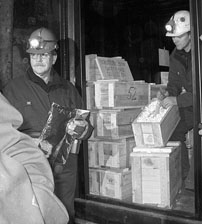 |
|
| Fig. 9. Early deposits of seed in 2005 at the Svalbard International Seed Vault. Dr. Bent Skovmand holds a packet of seeds as Dr. Cary Fowler examines a box for another packet. The vault would not reach full completion and be officially open until 2008. (Photo from the Skovmand family collection).
|
| |
In September of 2006 Bent was contacted by the Head of the Plant Pathology Department at the University of Minnesota. He had been selected as the 2007 recipient of the highest honor his old Department could bestow, the E. C. Stakman Award. He would receive the award and be a keynote speaker at the Department’s Centennial Celebration on the Saint Paul Campus on September 19, 2007. He was very pleased to be honored with his deceased mentor’s award, and to be asked to speak at the Centennial. He knew that Norman Borlaug, also his mentor and his hero, would try to attend. He began drafting his speech.
Then, during the winter holidays of 2007 he fell ill. He was diagnosed with a brain tumor. His body was worn down and his health finally failed. He would not live to give his September 2007 speech at the University of Minnesota. Nor would he celebrate the 2008 opening of the Svalvard International Seed Vault or see the Global Crop Diversity Trust become a reality. Nevertheless, his childhood yearning for new horizons and his determination to be of service to all mankind were fulfilled (Fig. 10). Sir Bent Skomvand’s dreams had become reality. He had done mankind a great service. What scientist/humanitarian could have asked for more?
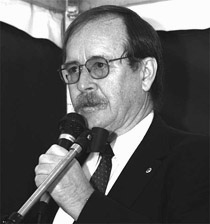
Fig. 10. Sir Bent Skovmand mixes wry humor with biological wisdom. "If the seeds disappear, so could your food − so could you."
Walker & Company: Susan Dworkin’s biography of Bent Skovmand,
The Viking in the Wheat Field –
thevikinginthewheatfield.com
Svalbard Global Seed Vault, from Wikipedia:
en.wikipedia.org/wiki/Svalbard_Global_Seed_Vault
FAO and Bioversity International:
Global Crop Diversity Trust
APS Press
E. C. Stakman: Statesman of Science
APSnet Features
Norman Borlaug: Plant Pathologist / Humanitarian
Durban House Publishing
The Man Who Fed the World
(book by Leon Hesser)
Bracing Books:
Borlaug
Volume 1: Right Off the Farm, 1914-1944
Volume 2: Wheat Whisperer, 1944-1959
